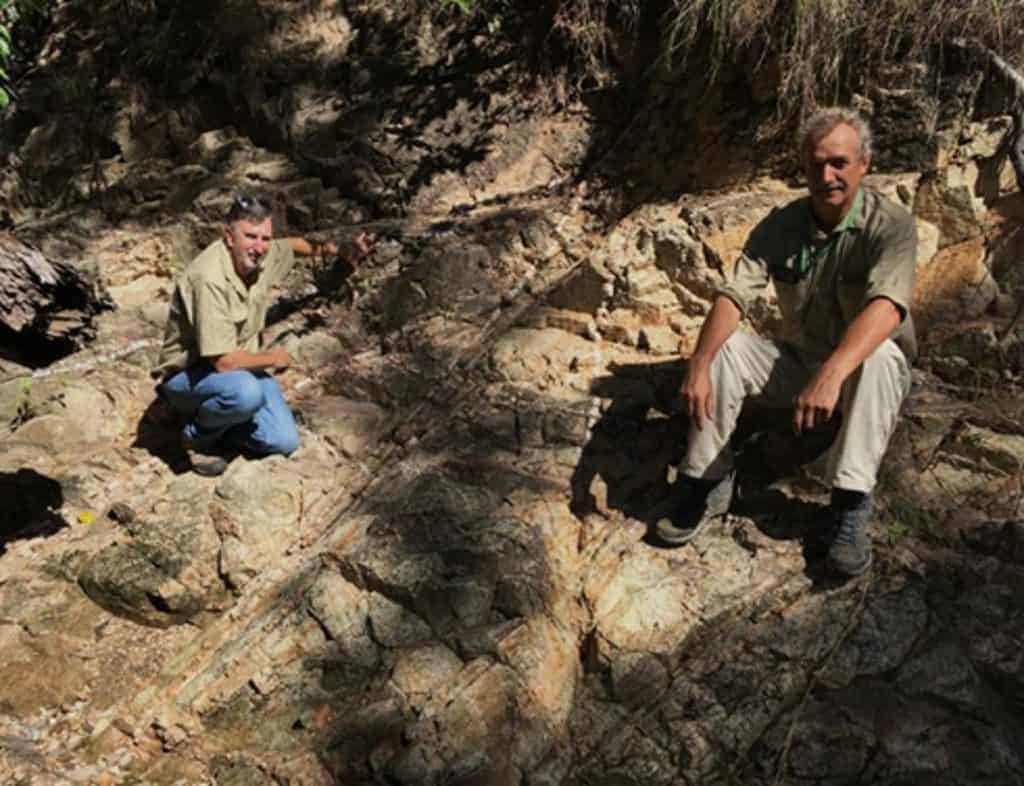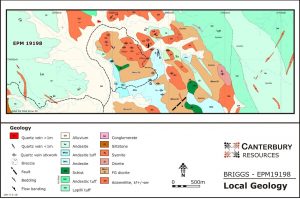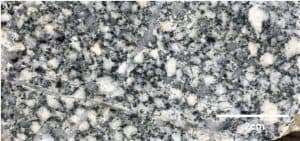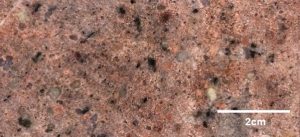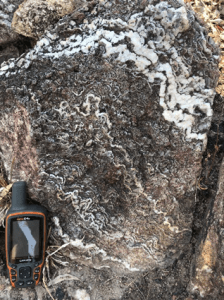Australia Exploration
In Australia Canterbury holds 100% of the Briggs (EPM 19198), Mannersley (EPM 18504) and Fig Tree Hill (EPM 27317) tenements, plus the Don River application (EPM 28588) which are prospective for large scale porphyry copper (± gold, ± molybdenum) mineralisation. The Briggs and Mannersley tenements were acquired from Rio Tinto which retains a 1.5% net smelter royalty. Alma Metals Limited has agreed to enter an Earn-in and Joint Venture Agreement covering the four tenements by funding up to $15.25m of exploration and assessment activity to earn up to 70% JV interest.
The four tenements are located inland from Gladstone, forming a contiguous 10km by 10km block, located at the southern end of the northwest–southeast trending Mt Morgan structural belt. The high-grade Mt Morgan mine produced around 8Moz of gold and 350,000t of copper before its closure in 1989. The potential to delineate an economic project in this region is enhanced by its accessibility to critical infrastructure, including power, transport, industrial services and skilled labour.
Canterbury’s Australian Assets:
Briggs (100%) – EPM 19198
A porphyry copper (± molybdenum) system with a 2km surface footprint. Canterbury completed a 5 hole, 2069m core drill program in 2019 at the Central Porphyry. A subsequent mineral resource study was undertaken and resulted in an Inferred Resource of 142.6Mt at 0.29% Cu (at a 0.2% Cu cut-off). Follow-up RC drilling, funded by Alma Metals under an option agreement, have resulted in the estimation of additional Exploration Targets of 455Mt to 850Mt at 0.20% to 0.35% Cu. Core drilling of these Exploration Targets commenced in October 2022.
Mannersley (100%) – EPM 18504
Another large porphyry copper (± molybdenum ± gold) system, albeit representing a more discrete target. Gold mineralisation appears to be hosted by calc-silicate peripheral skarns and intrusive breccias surrounding a central copper and molybdenum mineralised granodiorite stock.
Fig Tree Hill (100%) – EPM 27317
Both the Briggs and Mannersley porphyry systems are localised along major north-west trending structural features clearly visible in regional magnetic surveys. The Fig Tree Hill tenement covers structural extensions of both Briggs and Mannersley.
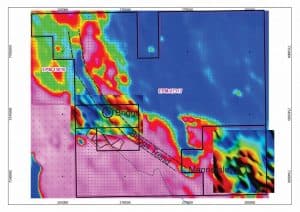
Briggs Project
At Briggs, past explorers have included Noranda (1969 – 1972), Geopeko (1970’s), Plutonic (1980’s), CRA Exploration (1990’s) and Rio Tinto (2011 – 2017), while at Mannersley, explorers have included Geopeko (1969 – 1972), Goldfields (1987), Asarco (1990 – 1991) and Rio Tinto (2010 to 2017).
These explorers have generated extensive geological datasets over the properties, outlining multiple large porphyry style copper ± molybdenum ± gold mineralisation systems.
The Briggs porphyry copper ± molybdenum is centred on a multi-phase granodiorite body of Permian age which intruded late Devonian volcanoclastic and sedimentary rocks of the Balaclava Formation. Intruding the granodiorite is a series of granite porphyry dykes and plugs with associated brain rock and quartz-rich rocks that are closely associated with copper – molybdenite mineralisation.
Mineralisation occurs in quartz-muscovite-sulphide veins and associated alteration. At deeper levels k-feldspar, magnetite, and fluorite also part of this stage, which suggests increasing temperature with depth.
Geologically Briggs appears to be similar to deposits such as Yerington and Ann Mason in Nevada and Erdenet in Mongolia.
Recognition of the association of copper-molybdenum mineralisation at Briggs with granite porphyry dykes/plugs and associated quartz and brain rock suggests exploration should be oriented towards a better understanding of these phases because they appear associated with better grades of mineralisation.
In addition, cross sections of Yerington show that zones of potassic alteration and copper mineralisation extend for 2km vertically so there is considerable scope for deeper drilling at Briggs to investigate the higher temperature part of the system.
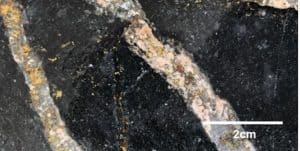
Briggs Quartz-K-Feldspar-Muscovite-Magnetite-Chalcopyrite Veins in Volcanoclastics. BD019-003 394.3m
In 2019 Canterbury drilled 5 holes for 2069m testing the Central Porphyry. All holes returned broad intersections of low-grade copper mineralisation. A resource estimate was completed and outlined an Inferred Resource of 142.8Mt at 0.29% Cu at a cut-off of 0.2% Cu.
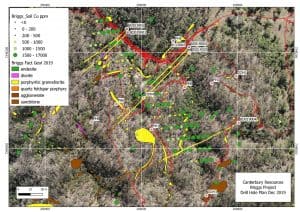
Briggs Central Porphyry, with Fact Geology, Copper Soil Geochemistry, Historic Drill Collars and CBY Hole Traces
Table of Significant Intercepts BD019-001 to BD019-005
| Hole No | From (m) | To (m) | Length (m) | Cu (%) | Mo (ppm) | Cut-off (% Cu) |
| BD019-001 | 6.0 | 203.6 | 197.6 | 0.22 | 7 | 0.1 |
| including | 79.0 | 96.0 | 17.0 | 0.31 | 3 | 0.3 |
| including | 138.0 | 148.0 | 10.0 | 0.36 | 7 | 0.3 |
| BD019-002 | 4.5 | 375.0 | 370.5 | 0.27 | 10 | 0.1 |
| including | 6.0 | 45.0 | 39.0 | 0.53 | 14 | 0.3 |
| including | 168.0 | 186.0 | 18.0 | 0.46 | 6 | 0.3 |
| BD019-003 | 5.2 | 136.0 | 130.8 | 0.20 | 34 | 0.1 |
| and | 152.0 | 398.8 | 246.8 | 0.30 | 10 | 0.1 |
| including | 226.0 | 254.0 | 28.0 | 0.83 | 17 | 0.3 |
| including | 369.7 | 398.8 | 29.0 | 0.37 | 19 | 0.3 |
| BD019-004 | 7.8 | 452.0 | 444.2 | 0.27 | 42 | 0.1 |
| including | 54.0 | 72.0 | 18.0 | 0.34 | 65 | 0.3 |
| including | 279.0 | 292.0 | 13.0 | 0.32 | 9 | 0.3 |
| including | 297.0 | 309.0 | 12.0 | 0.31 | 20 | 0.3 |
| including | 320.0 | 341.1 | 21.1 | 0.38 | 27 | 0.3 |
| including | 357.0 | 376.1 | 19.1 | 0.32 | 71 | 0.3 |
| including | 382.0 | 402.0 | 20.0 | 0.31 | 25 | 0.3 |
| including | 410.0 | 420.0 | 10.0 | 0.32 | 33 | 0.3 |
| including | 426.0 | 451.0 | 25.0 | 0.39 | 33 | 0.3 |
| BD019-005 | 8.5 | 169.0 | 160.5 | 0.24 | 22 | 0.1 |
| including | 44.0 | 75.0 | 31.0 | 0.38 | 13 | 0.3 |
| including | 115.0 | 125.0 | 10.0 | 0.31 | 6 | 0.3 |
| and | 175.0 | 411.0 | 236.0 | 0.20 | 8 | 0.1 |
| including | 295.0 | 306.0 | 11.0 | 0.50 | 7 | 0.3 |
| and | 440.0 | 568.8 | 128.8 | 0.24 | 21 | 0.1 |
| including | 446.0 | 467.0 | 21.0 | 0.31 | 15 | 0.3 |
| including | 546.3 | 562 | 15.7 | 0.30 | 15 | 0.3 |

Composite 3D Model of Central Porphyry at Briggs (GDP) used to Constrain the Block Model, Showing all Drillholes with Halo of Mineralised Volcanoclastics (MINSED). Quartz Zones Indicated in Brown
In late 2021 Alma Metals completed a 12-hole (1,446m) reverse circulation (RC) drilling program at Briggs under its exclusive Option and Earn-In Joint Venture Agreement. The results of this drilling confirmed extensive porphyry copper-molybdenum mineralisation up to 750m along strike from the existing mineral resource. Overall, porphyry copper-molybdenum mineralisation has now been logged in most holes drilled over a 1,500m strike-length, within a surface geochemical anomaly that is greater than 2,000m long and 750m wide, at greater than 1,000ppm Cu.
The RC drilling program represented the main component of the exploration commitment made by Alma Metals in the Option phase of its agreement with Canterbury, under which it can ultimately reach 70% ownership of the project by funding $16 million of assessment activity. Formal commencement of an Earn-in Joint Venture commenced at 1 July 2022.
Soil sampling over the Briggs porphyry copper system shows anomalous copper greater than 0.1% over three areas (Northern, Central and Southern). Geological mapping and limited drilling (diamond core and reverse circulation percussion) confirms that each of these three anomalies define outcropping mineralised granodioritic intrusions and adjacent volcanic sediments containing copper bearing quartz stockworks. Exploration Targets have been estimated for each of these three areas totaling 455Mt to 850Mt at 0.20% to 0.35% Cu (which excludes the Central Porphyry Inferred Resource of 142.8Mt at 0.29% Cu at a cut-off of 0.2% Cu).
A program of diamond core drilling, testing the Northern and Central Porphyry targets, commenced in October 2022.
Mannersley Project
The Mannersley porphyry was discovered in 1972 by Geopeko which drilled three shallow holes testing geochemical anomalies. However, these holes failed to test the core of the porphyry system.
Peripheral to the intrusive are a series of magnetite bearing skarns which appear to be shedding gold into creeks that flow radially away from the porphyry. Rio Tinto also reports visible gold in samples draining from the intrusive complex and there are many historical gold workings dotted along these creek systems. Canterbury regards these as being worthy of more detailed assessment.
The Company is also intrigued by the unusually large (~3.5km2) size of the Mannersley intrusive complex and the associated potassic (biotite) alteration which is atypical of Queensland porphyries.
Canterbury plans to complete detailed surface mapping and re-evaluate the historic geophysics to generate targets for scout drilling.
